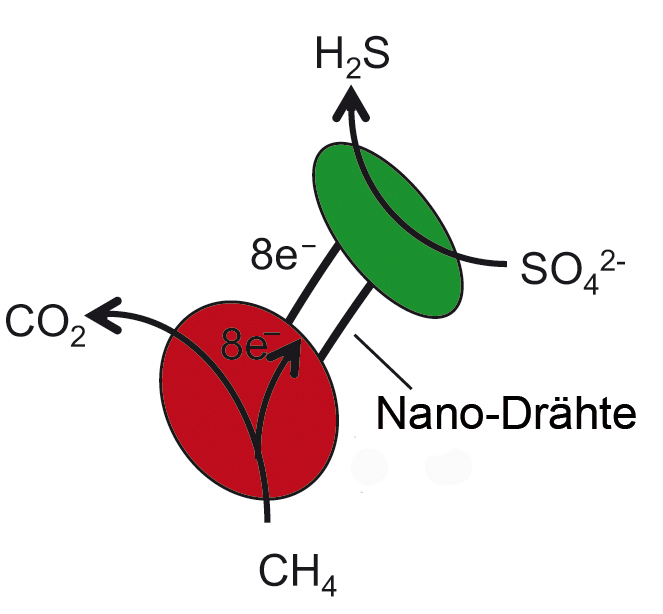Heavily Wired: How Microorganisms organise their power supply via nano-wires

The archaea depicted in red yield eight electrons from the oxidation of a single methane molecule. The electrons travel via the nanowires to the sulphate reducing bacteria (green). Max Planck Institute for Marine Microbiology, Bremen
Since more than a decade, scientists from Bremen, Germany, study how methane in the seabed is degraded by microorganisms. So far, it has remained a mystery how the methane consumers tap into the energy contained in methane, and how they could share that energy. New results show that direct interspecies electron transfer between cells is likely the solution to this puzzle.
Electric power as microbial energy source
It was a spectacular finding when in 2010 researchers discovered electrical wiring between microorganisms using iron as energy source. Immediately the question came up, if electric power exchange is common in other microbially mediated reactions.
One of the processes in question was the anaerobic oxidation of methane (AOM) that is responsible for the degradation of the greenhouse gas methane in the seafloor, and therefore has a great relevance for Earth climate. The microorganisms involved have been described for the first time in 2000 by researchers from Bremen and since then have been extensively studied.
The greenhouse gas methane in the seabed
In the ocean, methane is produced from the decay of dead biomass in subsurface sediments. The methane rises upwards to the seafloor, but before reaching the water column it is degraded by special consortia of archaea and bacteria. The archaea take up methane and oxidise it to carbonate. They pass on energy to their partner bacteria, so that the reaction can proceed.
The bacteria respire sulphate instead of oxygen to gain energy (sulphate reducers). This may be an ancient metabolism, already relevant billions of years ago when the Earth’s atmosphere was oxygen-free. Yet, today it remains unknown, how the anaerobic oxidation of methane works biochemically.
Dr. Gunter Wegener, who authors the publication together with PhD student Viola Krukenberg, says: “We focused on thermophilic AOM consortia living at 60 degrees Celsius. For the first time we were able to isolate the partner bacteria to grow them alone. Then we systematically compared the physiology of the isolate with that of the AOM culture. We wanted to know which substances can serve as an energy carrier between the archaea and sulphate reducers.”
Most compounds were ruled out quickly. At first, hydrogen was considered as energy source. However, the archaea did not produce sufficient hydrogen to explain the growth of sulphate reducers – hence the researchers had to change their strategy.
Direct power wires and electron transporters
One possible alternative was to look for direct connections channelling electrons between the cells. Using electron microscopy on the thermophilic AOM cultures this idea was confirmed. Dietmar Riedel, head of electron microscopy facilities at the Max Planck Institute in Goettingen says: “It was really challenging to visualize the cable-like structures. We embedded aggregates under high pressure using different embedding media. Ultrathin sections of these aggregates were then examined in near-native state using transmission electron microscopy.”
Viola Krukenberg adds: “We found all genes necessary for biosynthesis of the cellular connections called pili. Only when methane is added as energy source these genes are activated and pili are formed between bacteria and archaea.”
With length of several micrometres the wires can exceed the length of the cells by far, but their diameter is only a few nanometres. These wires provide the contact between the closely spaced cells and explain the spatial structure of the consortium, as was shown by a team of researchers led by Victoria Orphan from Caltech in the same issue of Nature.
Professor Antje Boetius, leader of the research group, explains how the research on the wired consortia will proceed: “Consortia of archaea and bacteria are abundant in nature. Our next step is to see whether other types also show such nanowire-like connections. It is important to understand how methane-degrading microbial consortia work, as they provide important functions in nature.”
Publication
Intercellular wiring enables electron transfer between methanotrophic archaea and bacteria. Gunter Wegener, Viola Krukenberg, Dietmar Riedel, Halina E. Tegetmeyer and Antje Boetius. Nature, 2015 doi:10.1038/nature15733
Involved research institutes
Max Planck Institute for Marine Microbiology, Bremen, Germany.
MARUM, Center for Marine Environmental Sciences, University Bremen, Germany.
Max Planck Institute for Biophysical Chemistry, Göttingen, Germany.
Alfred Wegener Institute Helmholtz Center for Polar and Marine Research, Bremerhaven, Germany.
Center for Biotechnology, Bielefeld University, Bielefeld, Germany.
For more information please contact
Dr. Gunter Wegener
Max Planck Institute for Marine Microbiology, Celsiusstrasse 1
D-28359 Bremen, Germany. Phone:+49 421 2028 867
gwegener@mpi-bremen.de
or the press officer
Dr. Manfred Schlösser
Max Planck Institute for Marine Microbiology, Celsiusstrasse 1
D-28359 Bremen, Germany. Phone:+49 421 2028 704
mschloes@mpi-bremen.de
http://www.mpi-bremen.de web site of the Max Planck Institute for Marine Microbiology
Media Contact
All latest news from the category: Life Sciences and Chemistry
Articles and reports from the Life Sciences and chemistry area deal with applied and basic research into modern biology, chemistry and human medicine.
Valuable information can be found on a range of life sciences fields including bacteriology, biochemistry, bionics, bioinformatics, biophysics, biotechnology, genetics, geobotany, human biology, marine biology, microbiology, molecular biology, cellular biology, zoology, bioinorganic chemistry, microchemistry and environmental chemistry.
Newest articles

A ‘language’ for ML models to predict nanopore properties
A large number of 2D materials like graphene can have nanopores – small holes formed by missing atoms through which foreign substances can pass. The properties of these nanopores dictate many…

Clinically validated, wearable ultrasound patch
… for continuous blood pressure monitoring. A team of researchers at the University of California San Diego has developed a new and improved wearable ultrasound patch for continuous and noninvasive…

A new puzzle piece for string theory research
Dr. Ksenia Fedosova from the Cluster of Excellence Mathematics Münster, along with an international research team, has proven a conjecture in string theory that physicists had proposed regarding certain equations….



